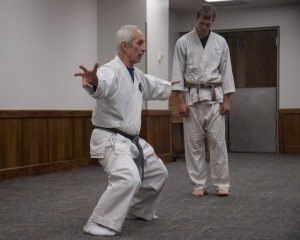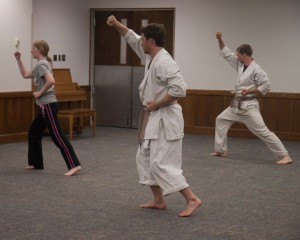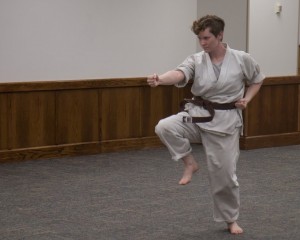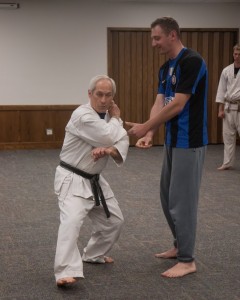[soundslides width=”620″ height =”533″ id=”373994″]
Luck is what Paul Sucher, sensei of the BYU Shotokan Karate Club and biology teacher at BYU, attributes to his long-time involvement in Shokotan.
BYU, the birthplace of a realistic and traditional style of Karate called Shotokan, started at BYU in September of 1964, three years before Sucher joined the club.

Sucher, an eager freshman, was up to trying new things.
“I went out for the gymnastics team, the wrestling team, the Judo Club and the Karate Club all simultaneously, and of course my grades suffered so I backed out,” Sucher said.
Sucher decided to solely pursue karate and then did the unexpected; he jumped ranks. In 1971, just four years after joining the club, he tested for his first-degree black belt and ever since has been the assistant instructor or instructor of the club.
The Shotokan Karate Club has beaten the odds through the years, as many of the martial arts clubs are now gone, and will be celebrating its 50th anniversary this coming fall, making it the oldest club on campus.
“We are seeing a little bit of a decline. I would like to see that reverse. I think there is a place for it because it develops discipline and focus, and my policy is that if you go on academic probation you can’t practice,” Sucher said.
Since becoming an instructor of the club in 1972, Sucher has only had to turn away one student who couldn’t practice until grades came back up.

Gichin Funakoshi, the creator of Shotokan, said the main focus of karate-do is the development of the character of the individual. Through the fire of facing your fears you learn how to focus on the moment and prioritize things, and students become disciplined.
Once the students learn how to focus and get into the moment of what they need to do and prioritize their actions, Sucher says, most of the students’ grades go up, instead of down, because of the mental skills they learn.
Sucher’s training benefited him during his time as a Utah State Police officer. “I think it helped keep me alive because I could see things developing before it got to the crisis point,” Sucher said.
Self defense is heavily emphasized in traditional karate. Sucher goes over all basic blocks, strikes and kicks with his students and then progresses to Kata, which are self defense forms against multiple opponents. After learning these techniques, students put them to the test by progressing through multiple levels of sparring and practicing self defense against the common weapons people are assaulted with, such as clubs, knives and handguns.

Amber Kiffer, a brown belt who has been involved in the club since she graduated from BYU two years ago, appreciates that Sucher brings in a lot of his police experience when teaching and demonstrating self defense moves.
Jeff Broadbent, an alumnus of the Shotokan Karate Club said he was grateful that his time in the club taught him how to live a well-balanced life.
“Participating in the club helped enforce the value of goal-setting, hard work, exercise and physical fitness and the importance of having hobbies and interests outside of work,” Broadbent said.
Sucher helps his students master many different techniques, but he says his job is to help them mentally, emotionally and spiritually as well — to help them learn that their bodies are capable of obeying their minds and doing things they weren’t capable of doing.
He shared an experience about a student named Joe who had cerebral palsy and couldn’t walk 20 feet without tripping over his own feet. Now he is a third-degree black belt and can defend himself effectively.
“My goal is to get every one of my students so that they can defend themselves physically within the first semester, four months, against more than about 50 percent of people out there that might bother them. So I teach strategy: how do you fight, when do you fight, where do you fight, when not to fight, which is probably one of the most important things,” Sucher said.
Not many would think running away would be the first technique you learn in karate, but Sucher teaches that if you can do that, you’ve won.
After learning the physical techniques, the next thing is learning the mental aspect of defense, to look a person right in the eye when you’re facing them in a combat situation. Sucher teaches, if you look away the aggressor has already defeated you mentally and emotionally as well.

“I teach the full meal,” Sucher said. “I not only teach how to do it, the language to it, the culture, but also the spiritual, mental and emotional gate. You have to be emotionally in a fight or you can’t win against a real opponent.”
Sucher stands by the standard that Shotokan is a building group; it is not about trash and bash, even though the practice is physical.
Patience is another important aspect of Shotokan. A person can’t get the skill in 10 easy lessons; Sucher speaks from 47 years of experience. Constant hard work is required.
Students learn everything they need to know to become a black belt in 18 months, but it usually takes three or four years to fully master all the physical, mental, emotional and spiritual skills that are required to become a black belt.
Sucher relies on his students to keep his skill level from dropping. He claims that their youthfulness, speed and strength is a gift from heaven and keeps him from dying of old age.
“How many other guys to you know that are about 65 years old still doing something like this? Not very many. I do pretty much everything they do. If they kick, I kick,” Sucher said.
Kiffer pointed out that all levels practice together. Everyone, from first-timers to black belts, practices the same moves, but they are focusing on different aspects.
Sucher compares this style of practice to preparing for heaven. “The course of perfection doesn’t ever end. You see this as something you can grow towards, perfection, and you keep practicing, and you keep growing,” Sucher said.
The Shotokan Karate Club will be hosting a 50th anniversary celebration in Fall 2014, and alumni of the club are invited to attend the reunion practice.




